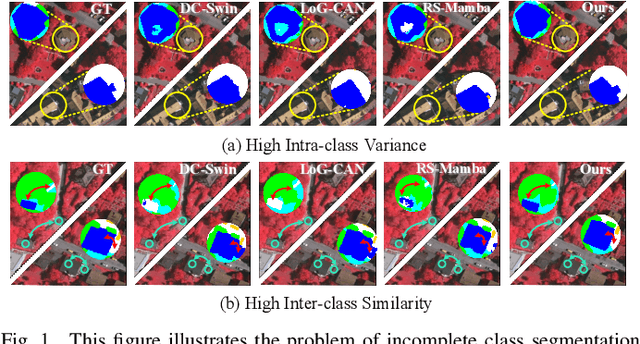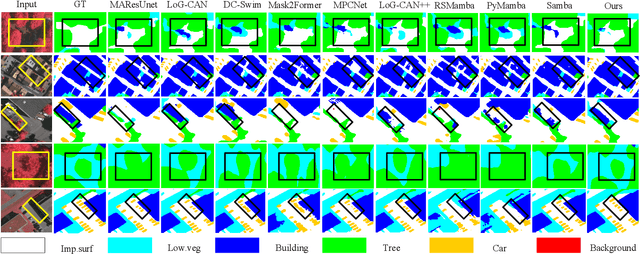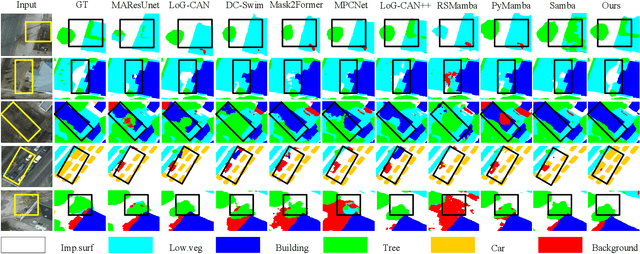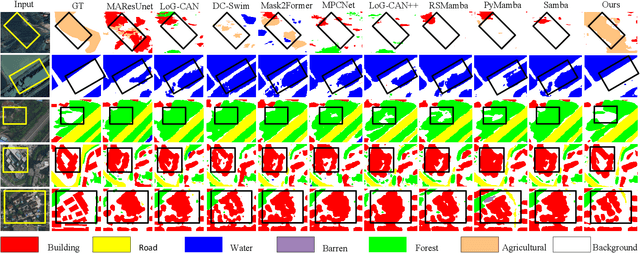Alex C. Kot
Nanyang Technological University, Singapore
ForensicsSAM: Toward Robust and Unified Image Forgery Detection and Localization Resisting to Adversarial Attack
Aug 10, 2025Abstract:Parameter-efficient fine-tuning (PEFT) has emerged as a popular strategy for adapting large vision foundation models, such as the Segment Anything Model (SAM) and LLaVA, to downstream tasks like image forgery detection and localization (IFDL). However, existing PEFT-based approaches overlook their vulnerability to adversarial attacks. In this paper, we show that highly transferable adversarial images can be crafted solely via the upstream model, without accessing the downstream model or training data, significantly degrading the IFDL performance. To address this, we propose ForensicsSAM, a unified IFDL framework with built-in adversarial robustness. Our design is guided by three key ideas: (1) To compensate for the lack of forgery-relevant knowledge in the frozen image encoder, we inject forgery experts into each transformer block to enhance its ability to capture forgery artifacts. These forgery experts are always activated and shared across any input images. (2) To detect adversarial images, we design an light-weight adversary detector that learns to capture structured, task-specific artifact in RGB domain, enabling reliable discrimination across various attack methods. (3) To resist adversarial attacks, we inject adversary experts into the global attention layers and MLP modules to progressively correct feature shifts induced by adversarial noise. These adversary experts are adaptively activated by the adversary detector, thereby avoiding unnecessary interference with clean images. Extensive experiments across multiple benchmarks demonstrate that ForensicsSAM achieves superior resistance to various adversarial attack methods, while also delivering state-of-the-art performance in image-level forgery detection and pixel-level forgery localization. The resource is available at https://github.com/siriusPRX/ForensicsSAM.
SGDFuse: SAM-Guided Diffusion for High-Fidelity Infrared and Visible Image Fusion
Aug 07, 2025Abstract:Infrared and visible image fusion (IVIF) aims to combine the thermal radiation information from infrared images with the rich texture details from visible images to enhance perceptual capabilities for downstream visual tasks. However, existing methods often fail to preserve key targets due to a lack of deep semantic understanding of the scene, while the fusion process itself can also introduce artifacts and detail loss, severely compromising both image quality and task performance. To address these issues, this paper proposes SGDFuse, a conditional diffusion model guided by the Segment Anything Model (SAM), to achieve high-fidelity and semantically-aware image fusion. The core of our method is to utilize high-quality semantic masks generated by SAM as explicit priors to guide the optimization of the fusion process via a conditional diffusion model. Specifically, the framework operates in a two-stage process: it first performs a preliminary fusion of multi-modal features, and then utilizes the semantic masks from SAM jointly with the preliminary fused image as a condition to drive the diffusion model's coarse-to-fine denoising generation. This ensures the fusion process not only has explicit semantic directionality but also guarantees the high fidelity of the final result. Extensive experiments demonstrate that SGDFuse achieves state-of-the-art performance in both subjective and objective evaluations, as well as in its adaptability to downstream tasks, providing a powerful solution to the core challenges in image fusion. The code of SGDFuse is available at https://github.com/boshizhang123/SGDFuse.
Prototype-Driven Structure Synergy Network for Remote Sensing Images Segmentation
Aug 06, 2025



Abstract:In the semantic segmentation of remote sensing images, acquiring complete ground objects is critical for achieving precise analysis. However, this task is severely hindered by two major challenges: high intra-class variance and high inter-class similarity. Traditional methods often yield incomplete segmentation results due to their inability to effectively unify class representations and distinguish between similar features. Even emerging class-guided approaches are limited by coarse class prototype representations and a neglect of target structural information. Therefore, this paper proposes a Prototype-Driven Structure Synergy Network (PDSSNet). The design of this network is based on a core concept, a complete ground object is jointly defined by its invariant class semantics and its variant spatial structure. To implement this, we have designed three key modules. First, the Adaptive Prototype Extraction Module (APEM) ensures semantic accuracy from the source by encoding the ground truth to extract unbiased class prototypes. Subsequently, the designed Semantic-Structure Coordination Module (SSCM) follows a hierarchical semantics-first, structure-second principle. This involves first establishing a global semantic cognition, then leveraging structural information to constrain and refine the semantic representation, thereby ensuring the integrity of class information. Finally, the Channel Similarity Adjustment Module (CSAM) employs a dynamic step-size adjustment mechanism to focus on discriminative features between classes. Extensive experiments demonstrate that PDSSNet outperforms state-of-the-art methods. The source code is available at https://github.com/wangjunyi-1/PDSSNet.
Temporal Unlearnable Examples: Preventing Personal Video Data from Unauthorized Exploitation by Object Tracking
Jul 10, 2025Abstract:With the rise of social media, vast amounts of user-uploaded videos (e.g., YouTube) are utilized as training data for Visual Object Tracking (VOT). However, the VOT community has largely overlooked video data-privacy issues, as many private videos have been collected and used for training commercial models without authorization. To alleviate these issues, this paper presents the first investigation on preventing personal video data from unauthorized exploitation by deep trackers. Existing methods for preventing unauthorized data use primarily focus on image-based tasks (e.g., image classification), directly applying them to videos reveals several limitations, including inefficiency, limited effectiveness, and poor generalizability. To address these issues, we propose a novel generative framework for generating Temporal Unlearnable Examples (TUEs), and whose efficient computation makes it scalable for usage on large-scale video datasets. The trackers trained w/ TUEs heavily rely on unlearnable noises for temporal matching, ignoring the original data structure and thus ensuring training video data-privacy. To enhance the effectiveness of TUEs, we introduce a temporal contrastive loss, which further corrupts the learning of existing trackers when using our TUEs for training. Extensive experiments demonstrate that our approach achieves state-of-the-art performance in video data-privacy protection, with strong transferability across VOT models, datasets, and temporal matching tasks.
Active Adversarial Noise Suppression for Image Forgery Localization
Jun 15, 2025Abstract:Recent advances in deep learning have significantly propelled the development of image forgery localization. However, existing models remain highly vulnerable to adversarial attacks: imperceptible noise added to forged images can severely mislead these models. In this paper, we address this challenge with an Adversarial Noise Suppression Module (ANSM) that generate a defensive perturbation to suppress the attack effect of adversarial noise. We observe that forgery-relevant features extracted from adversarial and original forged images exhibit distinct distributions. To bridge this gap, we introduce Forgery-relevant Features Alignment (FFA) as a first-stage training strategy, which reduces distributional discrepancies by minimizing the channel-wise Kullback-Leibler divergence between these features. To further refine the defensive perturbation, we design a second-stage training strategy, termed Mask-guided Refinement (MgR), which incorporates a dual-mask constraint. MgR ensures that the perturbation remains effective for both adversarial and original forged images, recovering forgery localization accuracy to their original level. Extensive experiments across various attack algorithms demonstrate that our method significantly restores the forgery localization model's performance on adversarial images. Notably, when ANSM is applied to original forged images, the performance remains nearly unaffected. To our best knowledge, this is the first report of adversarial defense in image forgery localization tasks. We have released the source code and anti-forensics dataset.
MTL-UE: Learning to Learn Nothing for Multi-Task Learning
May 08, 2025Abstract:Most existing unlearnable strategies focus on preventing unauthorized users from training single-task learning (STL) models with personal data. Nevertheless, the paradigm has recently shifted towards multi-task data and multi-task learning (MTL), targeting generalist and foundation models that can handle multiple tasks simultaneously. Despite their growing importance, MTL data and models have been largely neglected while pursuing unlearnable strategies. This paper presents MTL-UE, the first unified framework for generating unlearnable examples for multi-task data and MTL models. Instead of optimizing perturbations for each sample, we design a generator-based structure that introduces label priors and class-wise feature embeddings which leads to much better attacking performance. In addition, MTL-UE incorporates intra-task and inter-task embedding regularization to increase inter-class separation and suppress intra-class variance which enhances the attack robustness greatly. Furthermore, MTL-UE is versatile with good supports for dense prediction tasks in MTL. It is also plug-and-play allowing integrating existing surrogate-dependent unlearnable methods with little adaptation. Extensive experiments show that MTL-UE achieves superior attacking performance consistently across 4 MTL datasets, 3 base UE methods, 5 model backbones, and 5 MTL task-weighting strategies.
Open-set Anomaly Segmentation in Complex Scenarios
Apr 28, 2025Abstract:Precise segmentation of out-of-distribution (OoD) objects, herein referred to as anomalies, is crucial for the reliable deployment of semantic segmentation models in open-set, safety-critical applications, such as autonomous driving. Current anomalous segmentation benchmarks predominantly focus on favorable weather conditions, resulting in untrustworthy evaluations that overlook the risks posed by diverse meteorological conditions in open-set environments, such as low illumination, dense fog, and heavy rain. To bridge this gap, this paper introduces the ComsAmy, a challenging benchmark specifically designed for open-set anomaly segmentation in complex scenarios. ComsAmy encompasses a wide spectrum of adverse weather conditions, dynamic driving environments, and diverse anomaly types to comprehensively evaluate the model performance in realistic open-world scenarios. Our extensive evaluation of several state-of-the-art anomalous segmentation models reveals that existing methods demonstrate significant deficiencies in such challenging scenarios, highlighting their serious safety risks for real-world deployment. To solve that, we propose a novel energy-entropy learning (EEL) strategy that integrates the complementary information from energy and entropy to bolster the robustness of anomaly segmentation under complex open-world environments. Additionally, a diffusion-based anomalous training data synthesizer is proposed to generate diverse and high-quality anomalous images to enhance the existing copy-paste training data synthesizer. Extensive experimental results on both public and ComsAmy benchmarks demonstrate that our proposed diffusion-based synthesizer with energy and entropy learning (DiffEEL) serves as an effective and generalizable plug-and-play method to enhance existing models, yielding an average improvement of around 4.96% in $\rm{AUPRC}$ and 9.87% in $\rm{FPR}_{95}$.
Towards Model Resistant to Transferable Adversarial Examples via Trigger Activation
Apr 20, 2025Abstract:Adversarial examples, characterized by imperceptible perturbations, pose significant threats to deep neural networks by misleading their predictions. A critical aspect of these examples is their transferability, allowing them to deceive {unseen} models in black-box scenarios. Despite the widespread exploration of defense methods, including those on transferability, they show limitations: inefficient deployment, ineffective defense, and degraded performance on clean images. In this work, we introduce a novel training paradigm aimed at enhancing robustness against transferable adversarial examples (TAEs) in a more efficient and effective way. We propose a model that exhibits random guessing behavior when presented with clean data $\boldsymbol{x}$ as input, and generates accurate predictions when with triggered data $\boldsymbol{x}+\boldsymbol{\tau}$. Importantly, the trigger $\boldsymbol{\tau}$ remains constant for all data instances. We refer to these models as \textbf{models with trigger activation}. We are surprised to find that these models exhibit certain robustness against TAEs. Through the consideration of first-order gradients, we provide a theoretical analysis of this robustness. Moreover, through the joint optimization of the learnable trigger and the model, we achieve improved robustness to transferable attacks. Extensive experiments conducted across diverse datasets, evaluating a variety of attacking methods, underscore the effectiveness and superiority of our approach.
Digital Staining with Knowledge Distillation: A Unified Framework for Unpaired and Paired-But-Misaligned Data
Apr 14, 2025Abstract:Staining is essential in cell imaging and medical diagnostics but poses significant challenges, including high cost, time consumption, labor intensity, and irreversible tissue alterations. Recent advances in deep learning have enabled digital staining through supervised model training. However, collecting large-scale, perfectly aligned pairs of stained and unstained images remains difficult. In this work, we propose a novel unsupervised deep learning framework for digital cell staining that reduces the need for extensive paired data using knowledge distillation. We explore two training schemes: (1) unpaired and (2) paired-but-misaligned settings. For the unpaired case, we introduce a two-stage pipeline, comprising light enhancement followed by colorization, as a teacher model. Subsequently, we obtain a student staining generator through knowledge distillation with hybrid non-reference losses. To leverage the pixel-wise information between adjacent sections, we further extend to the paired-but-misaligned setting, adding the Learning to Align module to utilize pixel-level information. Experiment results on our dataset demonstrate that our proposed unsupervised deep staining method can generate stained images with more accurate positions and shapes of the cell targets in both settings. Compared with competing methods, our method achieves improved results both qualitatively and quantitatively (e.g., NIQE and PSNR).We applied our digital staining method to the White Blood Cell (WBC) dataset, investigating its potential for medical applications.
Temporal-Guided Spiking Neural Networks for Event-Based Human Action Recognition
Mar 21, 2025



Abstract:This paper explores the promising interplay between spiking neural networks (SNNs) and event-based cameras for privacy-preserving human action recognition (HAR). The unique feature of event cameras in capturing only the outlines of motion, combined with SNNs' proficiency in processing spatiotemporal data through spikes, establishes a highly synergistic compatibility for event-based HAR. Previous studies, however, have been limited by SNNs' ability to process long-term temporal information, essential for precise HAR. In this paper, we introduce two novel frameworks to address this: temporal segment-based SNN (\textit{TS-SNN}) and 3D convolutional SNN (\textit{3D-SNN}). The \textit{TS-SNN} extracts long-term temporal information by dividing actions into shorter segments, while the \textit{3D-SNN} replaces 2D spatial elements with 3D components to facilitate the transmission of temporal information. To promote further research in event-based HAR, we create a dataset, \textit{FallingDetection-CeleX}, collected using the high-resolution CeleX-V event camera $(1280 \times 800)$, comprising 7 distinct actions. Extensive experimental results show that our proposed frameworks surpass state-of-the-art SNN methods on our newly collected dataset and three other neuromorphic datasets, showcasing their effectiveness in handling long-range temporal information for event-based HAR.
 Add to Chrome
Add to Chrome Add to Firefox
Add to Firefox Add to Edge
Add to Edge